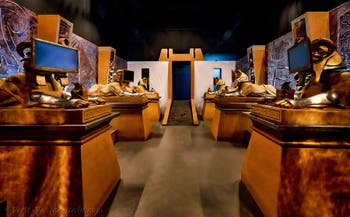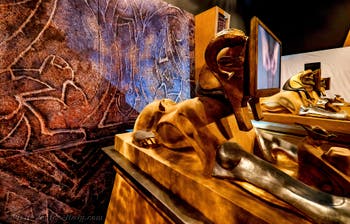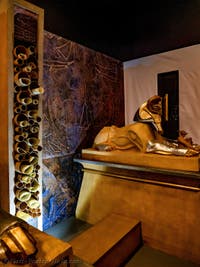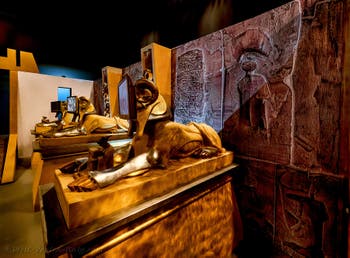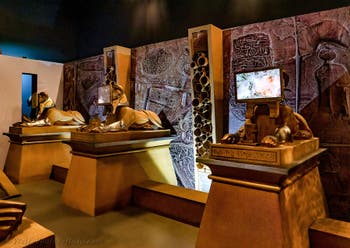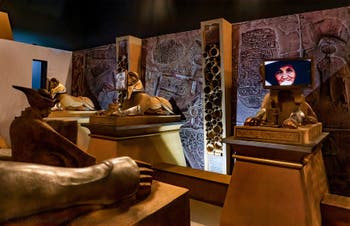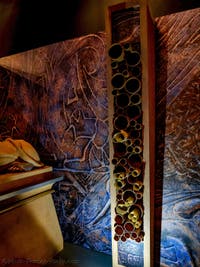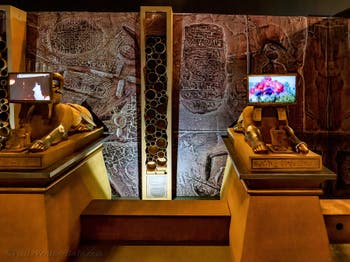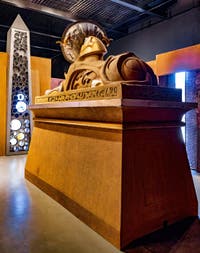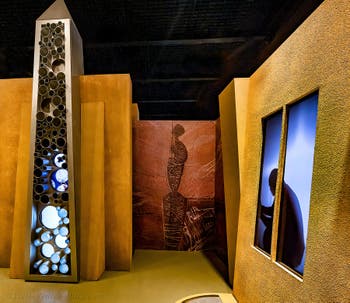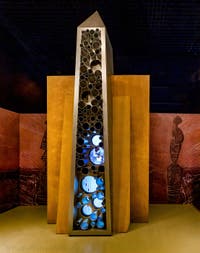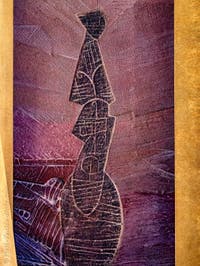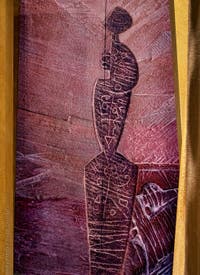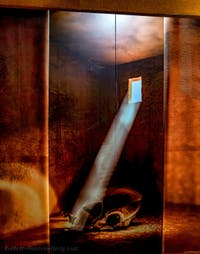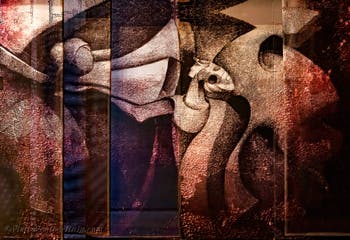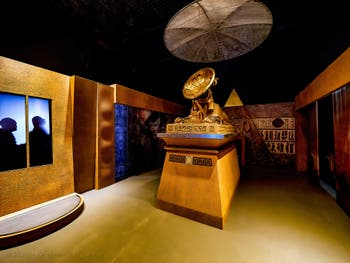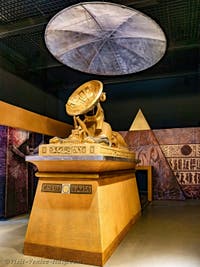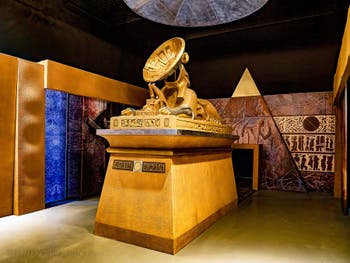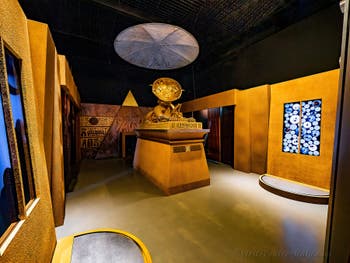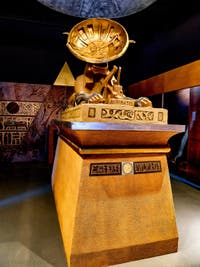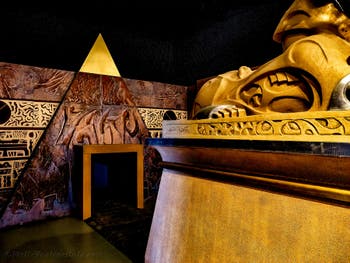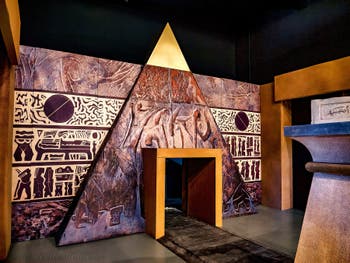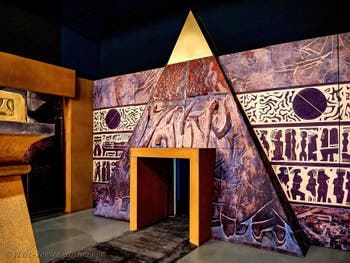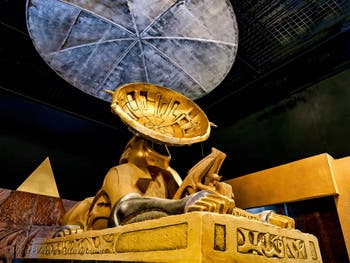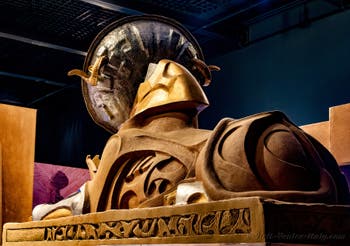Biennale Biennale Art | Architecture
Biennale Art 2024 | 2022 | 2019 | 2017
Artists Armitage | Bove | Bendayan | Bertlmann | Canosa | Chiha/Karim/Abdallah | Condo | Da Corte | David | Gruyter/Thys | Hamilton | Hernandez | Ihrman | Jamie | Jarpa | Jungerman | Kensmil | Kolíbal | Liu Wei | Marclay | Mehretu | Minoliti | Moulene | Muholi | Mulleady | Ozbolt | Pieski | Prouvost | Puryear | Shishkin | Singer | Sokurov | Stanczak | Taylor | Upson | Ursuta | Wagner/Burca | Wilkes| Yi A. | Yoon
Khnum : Islam and Moataz Abdallah, Ahmed Chihah, Ahmad Abdel Karim Venice Biennale International Art Exhibition
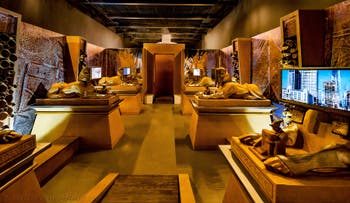
Khnum Sphinxes Room The God Khnum (or Khnum) is mentioned in the Book of the Dead by the ancient Egyptians.
During his journey in the afterlife, the deceased encounters evil beings ready to destroy him to prevent him from gaining eternal life.
Khnum is a protective god coming to his rescue:
"Back! Go away, you demon with an open mouth! I am Khnum, Lord of Pshenu."
Khnum, a friend of Good and mediator with the sun god Ra, came to Venice to tell visitors about the history and civilization of his country, using modern new media techniques.
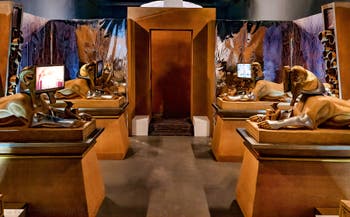
Khnum Sphinxes Room Four Egyptian artists have beautifully presented Khnum as an extraordinary witness who has spanned the centuries and known all the periods of their country’s history.
Ahmed Chiha, Ahmad Abdel Karim, Islam Abdallah and Moataz Abdallah created this work together to respond to the theme of the 2019 Venice Biennale: can you live an interesting time when you live your present by searching for the essence of the past.
We enter the Egyptian pavilion to discover the antechamber of a marvellous temple that presents an alley of sphinxes with rams’ heads that recalls that of Luxor.
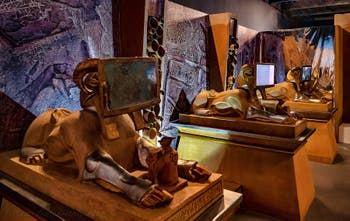
Khnum Sphinxes Room The sphinxes witnessed the life of the ancient Egyptians. They are the memory of their civilization.
Even today, they continue this "work of memory" and are witnesses of the latest technological advances employed by those who come to contemplate them.
Tablet screens here cover the faces of the rams of Khnum, which thus synthesize the past and the present.
The image is universal: everyone understands visual messages despite the diversity of languages and cultures.
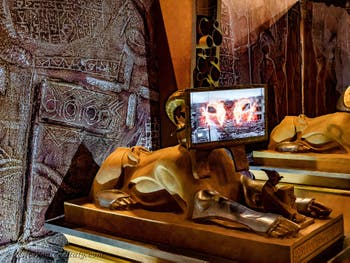
Khnum Sphinxes Room The rams of Khnum turn their heads from left to right, showing us their screens where images from all over the world pass and remind us that the ancient Egyptians were the forerunners of science and technology.
The quest for immortality stimulated their desire to unravel the mysteries of life and death, as well as their desire to know the secrets of the universe.
By practising medicine and mummification, astronomy, alchemy, architecture and surveying (which are at the origin of geometry), painting, music, sculpture..., this is how they established the foundations of the main fields of knowledge and art.
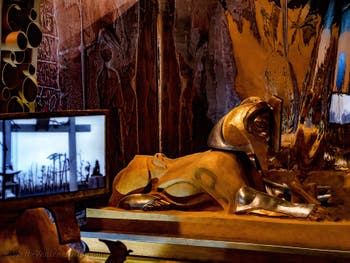
Khnum Sphinxes Room Passing through the ram-headed sphinxes, don’t forget to contemplate the beautiful wall drawings composed of simple shapes and geometric figures as well as the silhouettes that adorn the walls of this Hall of Memory or "Khnum-witness".
They bring us closer to this distant past of humanity where we wrote in hieroglyphs on papyrus scrolls, similar to the stacked scrolls shown here.
At the end of this sacred path, one crosses a high door to access the sanctuary room, where one is struck by the majesty of a great sphinx on its pedestal and surprised to see its head replaced by a satellite dish raised to capture the light of a luminous disk.
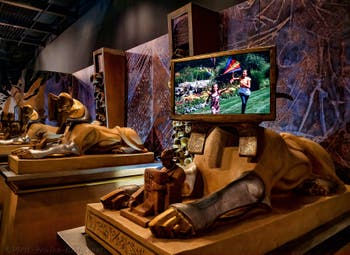
Khnum Sphinxes Room A sphinx-satellite dish was placed under the immensity of the sky to welcome the light and heat of the solar disk at the zenith, a symbol of the God Ra, the Master of the Universe of ancient times.
A "Khnum-satellite dish" turned to the sky to capture satellite broadcasts that give it news from all over the world while travelling around the Earth.
A sweet fragrance floats in this room to add to the mysterious beauty of the drawings on the walls.
These drawings evoke esoteric drawings illustrating religious mysteries and myths of the origin of life, death, and the existence of a world beyond.
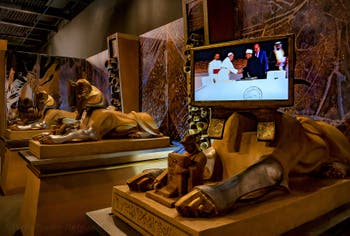
Khnum Sphinxes Room To assist the deceased in his journey to the afterlife, where he was judged and threatened by demons before he could one day be resurrected, the ancient Egyptians sought the help of the gods by reading The Book of the Dead aloud.
Here are some excerpts from the Book of the Dead where the defence of the deceased takes the form of a negative confession:
"O you, deities, who sit in the vast Hall of Justice, I greet you!
Do not insist on my sins before the God who is your Lord! In truth, I know you, and I know your names! Don’t abandon me to the executioner’s cleaver!
Khnum Sphinxes Room [...] Make Truth Hear to the Lord of the Universe!
Because I did, only what was true and right during my life on Earth.
I’ve never cursed a god.
[...] I gave bread to the hungry, water to the thirsty, clothes to the naked man, and a boat to the castaway.
To the gods, I made offerings libations to the sanctified Spirits.
[...] Deliver me from Babai who, on the Day of the Great Judgment, feeds on the bowels of the Mighty! (Babai: crocodile-headed deity that devoured damned souls).
Khnum Sphinxes Room [...] Let me enter your home!
Because I did not commit fraud or sin of any kind.
I did not give false testimony.
Let no harm be done to me!
Because I was fed on Truth and Justice.
Pure is my mouth! My hands are pure!
Let me hear, coming from you, this word:
Oh! Come in peace, Soul who is coming here!
Come in peace."
Book of the Dead of the Ancient Egyptians
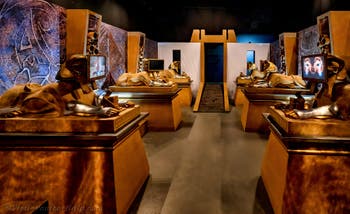
Khnum Sphinxes Room "Khnum," the receptacle of the oracles that deciphered the messages of heaven, remains the faithful guardian of the secrets of the Temple.
"Khnum", the storyteller who has seen and retained everything, is the messenger that addresses everyone by showing that the search for the past stimulates reflection with the hope and satisfaction of discovery.
In this Egyptian pavilion of the Venice Art Biennale, passing through a low door like those of the Egyptian tombs, we leave the sanctuary of Khnum thinking that we are living in a great time when knowledge and contemplation of works of art are accessible to all.
Artists Armitage | Bove | Bendayan | Bertlmann | Canosa | Chiha/Karim/Abdallah | Condo | Da Corte | David | Gruyter/Thys | Hamilton | Hernandez | Ihrman | Jamie | Jarpa | Jungerman | Kensmil | Kolíbal | Liu Wei | Marclay | Mehretu | Minoliti | Moulene | Muholi | Mulleady | Ozbolt | Pieski | Prouvost | Puryear | Shishkin | Singer | Sokurov | Stanczak | Taylor | Upson | Ursuta | Wagner/Burca | Wilkes| Yi A. | Yoon
Biennale Art 2024 | 2022 | 2019 | 2017
Biennale Biennale Art | Architecture
Back to Top of Page



